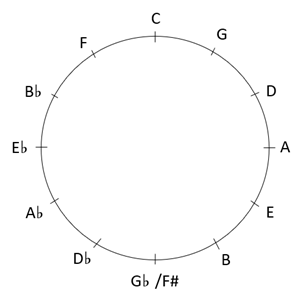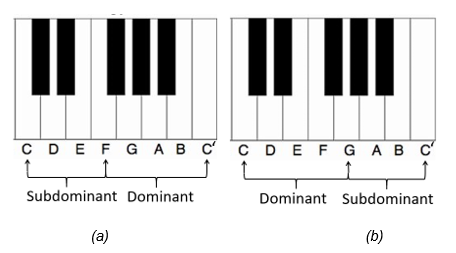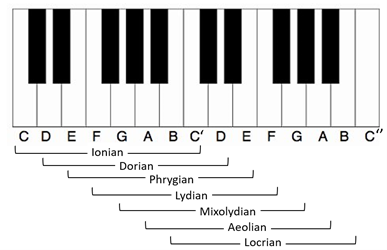In the first part of my series entitled Music, mathematics, and physics, I explained why we have 12 notes in western music, but spent very little time explaining what to do with these notes. In this article, I will look at scales, which is the way these 12 notes are grouped together. Scales are like the bricks and mortar that bind songs together and tell us immediately whether we are listening to classical, flamenco, or blues.
In brief summary, we get the 12 notes one at a time by adding dominants, which are notes found by multiplying the frequency of the previous note by 3/2. Doing this 12 times gets us to a note an octave higher than where we started. I finished the first article by arranging the 12 dominants into the circle of fifths, shown below:

The circle of dominants, or fifths.
But why is this called the circle of fifths, and where do the names associated with each note come from? To understand this, remember that another way of arranging the dominants comes from always keeping the relative frequency of the note between 1 and 2. This means that when multiplication by 3/2 produces a number that is greater than 2, we scale it back by a factor of ½, which moves the note down by an octave.
Any of the 12 notes on the circle of fifths can be thought of as the tonic note, which is the note that our ear hears as being the focus in a song. Consider three consecutive notes on the circle of fifths, for example F, C, and G. If we let F be the tonic, C is the dominant above F, and G is the dominant above C. The initial frequency ratios of these three notes are 1, 3/2, and 9/4, but we multiply the third ratio by 1/2 to get 9/8, which keeps the frequency ratio between 1 and 2. If we make the C the tonic by multiplying all three ratios by 2/3, we get ratios of 2/3, 1, and 3/2. F now has a frequency ratio of 2/3, which is a ratio we never saw by moving clockwise around the circle. This frequency ratio gives us what is called the sub-dominant. Another name for the subdominant is the fourth, the reason for which will be explained shortly. There is no reason why we could not develop the circle of fifths by moving counterclockwise around the circle and creating a circle of sub-dominants, or circle of fourths. The fact that any three consecutive notes on the circle of fifths consist of the subdominant, tonic, and dominant is the most important relationship in all western music. Almost every piece of music written, from Bach to Dylan, is based on the chords derived from these three notes.
Now let’s keep moving around the circle of fifths by adding four dominants. Starting again on F gives us F, C, G, D, A, E, B. Scaling the frequency ratios of these notes between 1 and 2 to confine them to a single octave, and adding the C an octave above, allows us to arrange the notes from lowest to highest frequency and gives us C, D, E, F, G, A, B, C’, where C’ is double the frequency of C. We can visualize this is on a piano, where the octave above middle C is shown below.

One octave on a piano keyboard, starting at middle C.
The relative distance between any two notes is called an interval. The smallest interval between keys is called a semitone, and two semitones make up a whole tone. The white keys are often referred to as naturals, and are given alphabetic names between A and G. The black keys are named in relation to their adjacent white keys. The terms sharp and flat are used to indicate a semitone change higher and lower than the adjacent natural notes. For example, the black key directly above D is called D sharp (or D#), while the one directly below is D flat (or D♭). Each black key, therefore, has two names, depending on what natural note you are relating it to. Notice that the interval between both E and F, and B and C is a semitone. If you play the naturals in order starting from C to C’, this is called the C major scale. On the piano keyboard, you can see that it involves playing all the white notes from any C to the C an octave higher. On the treble clef, the C major scale is written:

The C major scale written on the treble clef.
On the guitar, the notes are created by pressing on the strings to shorten their length. Here is a diagram of a guitar in standard tuning. (The strings appearing from bottom to top are tuned to E, A, D, G, B, and E’, respectively.) Each fret on the guitar is one semitone higher than the previous fret.

The semi-tones between C and C one octave higher, shown on a guitar string.
The tone and semitone relationships are more obvious on the guitar than on the piano, and it is clear from the above diagram that the intervals in a major scale are T-T-S-T-T-T-S, where T stands for tone and S stands for semitone.
This answers the question about why the naming of the notes on the circle of fifths, and lets us understand where the terms “fifth” and “fourth” come from. Look at the notes F, C, and G on the piano as seen in the figures below. The sub-dominant is called the fourth because it refers to the note that is four steps above the tonic, and the dominant is called the fifth because it is four steps away from the tonic. The figure on the left shows that C to F is a subdominant interval, or fourth, since F is four steps away from C. And F to C is a dominant interval, or fifth. The figure on the right shows that the interval from C to G is a fifth, and G to C is a fourth. Also, notice that if you move up a dominant interval and then a sub-dominant interval on a piano, or vice versa, you have gone an interval of a full octave. The octave, dominant, and sub-dominant are called “perfect” intervals in music theory.
 The relationship between the subdominant and dominant for (a) C and F, and (b) C and G.
The relationship between the subdominant and dominant for (a) C and F, and (b) C and G.
The C scale is not the only major scale. Choosing any seven consecutive notes on the circle of fifths gives you the notes of a major scale where the second note in the sequence is the tonic. For example, if you go from C to F# on the circle of fifths, the tonic will be G, and its major scale will contain an F#. If you go from B♭ to E, the tonic will be F, and the major scale will contain a B♭. These two scales are shown below on the treble clef:

The G major scale (left) and the F major scale (right).
There are 12 major scales in total, and each scale has progressively more sharps or flats. But they have the same relative sound to our ears because the intervals between each note are preserved. Rather than keep repeating the sharps and flats, they are written next to the clef symbol 🎼, which is called the key signature of a piece of music.
The Greeks were the first to discover the major scale, which they called the Ionian mode. They developed six other modes, by playing through the notes consecutively starting on a different note of the major scale. In the key of C, the other modes are Dorian (D), Phrygian (E), Lydian (F), Mixolydian (G), Aeolian (A), and Locrian (B), as shown below.

The seven Greek modes.
On a piano, play through the seven modes, paying close attention to the first three notes of each mode. Each mode has a distinctive sound, which could be called “happy” or “sad”. The “happy” modes are the Lydian, Ionian, and Mixolydian, and the sad modes are the other four. What separates them is the interval between the tonic and the third note, which contains two tones for the “happy” modes, and is called a major third, and one-and-a-half tones for the “sad” modes, called a minor third.
This leads us to minor scales. When you hear a sad song, it is probably composed using a minor scale. From the modes, the most common minor scale is the Aeolian, which is also called the natural minor. The natural minor scale consists of the intervals T-S-T-T-S-T-T, and we can also think of it as a major scale with the third, sixth, and seventh notes lowered by one semitone. Western music has developed two other minor scales, the harmonic minor, and the melodic minor. The harmonic minor is the same as the natural minor, but with its seventh note raised by one semitone. It is the minor scale most used in western music (think Hotel California). The melodic minor is the major scale with a flatted third. In jazz, it is played the same in both ascending and descending form, but, in classical music, the descending form is the same as the natural (Aeolian) minor. Two other important terms are the relative minor scale, which is derived from the sixth note of the major scale (i.e., the relative minor of C major is A minor), and the parallel minor scale, which has the same tonic as the major scale but has several notes changed depending on the type of minor scale (i.e., the parallel minor of C major is C minor).
We can also apply the terms relative and parallel to the Greek modes. Before leaving the modes, there are several others that should be discussed. The Phrygian mode, which is a natural minor scale with a flatted second note, is the basis of most flamenco music. Listen to the flamenco-inspired song White Rabbit by Jefferson Airplane. The opening solo is entirely in the Phrygian mode. The Dorian scale is a natural minor scale with a raised sixth note that is used by jazz and blues musicians. For example, So What from Miles Davis’s Kind of Blue album is based entirely on the Dorian scale. And if you listen to solos by Eric Clapton and Carlos Santana, you often hear the Dorian mode. However, Eric Clapton is much more likely to be using a pentatonic scale, so that is where we will finish.
Recall that to build the major scale we used seven consecutive notes on the circle of fifths, where the tonic was the second of those notes. To build the pentatonic scale, we use five consecutive notes, but now the tonic is the first note. For example, if we start at C, we get the notes C, G, D, A, E. Scaling the frequency ratios so they are arranged within an octave, and adding the octave, gives us C, D, E, G, A, C’. This is called the major pentatonic scale and omits the fourth and seventh notes of the major scale. The minor pentatonic scale has the same notes, but its tonic is from the relative minor, which is A in the key of C, and therefore is written A, C, D, E, G, A. The major and minor pentatonic scales are used in traditional folk music. More recently, they have been used as the basis for improvisation in blues and country music. For example, listen to B.B. King’s solo on The Thrill is Gone, and Willie Nelson’s solo on the tune Walkin’. The Thrill is Gone is in B minor, so B.B. plays a B minor pentatonic. Walkin’ is in D major, so Willie plays a D major pentatonic. Since B minor is the relative minor to D major, both solos contain the same notes! The same is true for Eric Clapton’s solos on Cocaine and Knocking on Heaven’s Door (E minor pentatonic and G major pentatonic have the same notes).
The chord structure behind these songs is equally important, and will be made clear in my next article, which discusses harmony and chords.
(Brian Russell – BIG Media Ltd., 2022)


